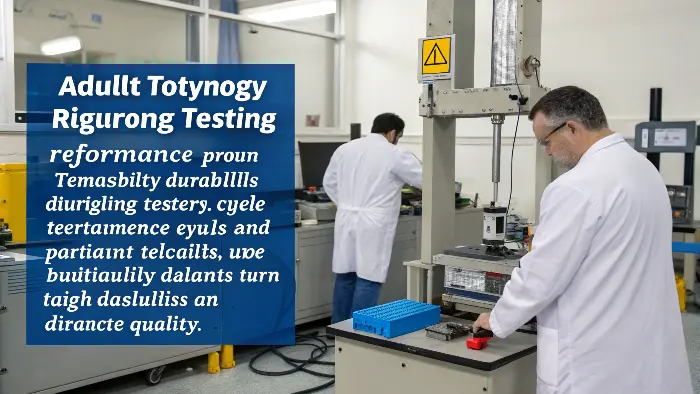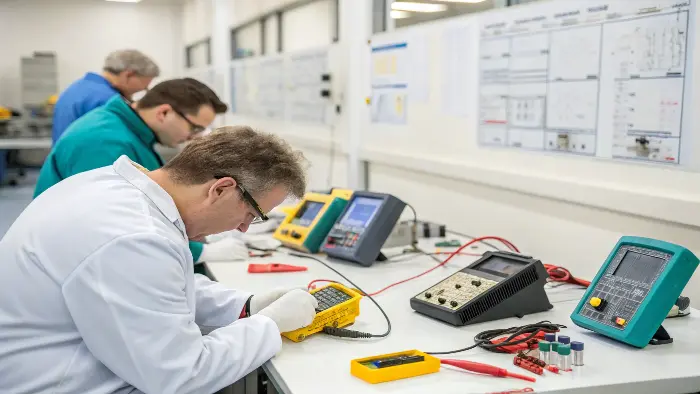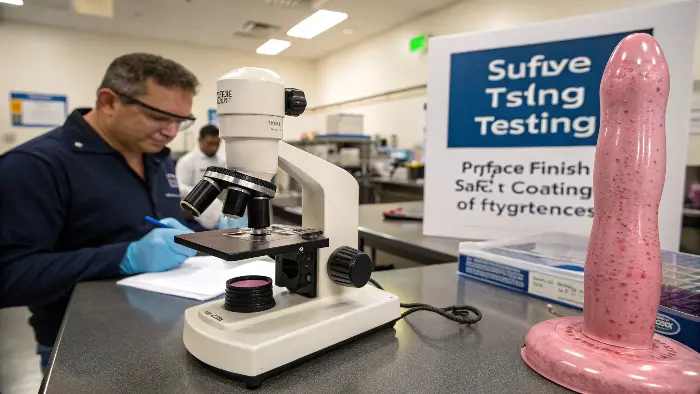Struggling with product returns or safety concerns? Subpar toys can ruin your brand. A dedicated testing lab ensures quality, safety, and customer satisfaction, protecting your reputation.
A basic in-house lab for adult toy manufacturers should include equipment for material analysis (like FTIR for silicone purity), physical/mechanical testing (tensile testers, durometers), chemical safety (XRF for heavy metals), and dimensional accuracy checks. This setup is key to ensuring product safety, quality, and compliance.
You know, setting up a testing lab might seem like a big step, but believe me, it’s one of the best investments you can make for your adult toy brand. It’s about taking control of your quality and giving your customers the peace of mind they deserve. I’ve seen firsthand how catching a potential issue before it leaves the factory can save a ton of headaches – and money – down the line. So, let’s dive into what makes a good lab tick, shall we? It’s not just about fancy machines; it’s about a commitment to excellence that your customers will feel.
Why is In-House Material Testing Non-Negotiable for Adult Toys?
Worried about what’s really in your adult toys? Material ambiguity can lead to safety scares and brand damage. Knowing your materials inside out is fundamental. It’s the bedrock of trust with your customers.
In-house material testing is non-negotiable because it verifies the exact composition and safety of materials like silicone, TPE, or glass. This ensures they are body-safe, free from harmful substances (phthalates, heavy metals), and meet quality standards before they even hit the production line.
When I first started in this industry, the focus on materials wasn’t as intense as it is today. But boy, have things changed – and for the better! For adult toys, the material is everything. It’s what touches your customer’s most intimate areas. So, you absolutely have to get it right. We’re talking about ensuring materials are truly body-safe. This means no nasty surprises like phthalates, heavy metals, or other irritants. I recall a specific incident years ago, before we had our full testing suite, where a supplier swore a batch of TPE was top-grade. It felt okay, but something was slightly off in the initial samples once they were molded. Luckily, we sent it for third-party testing, and it turned out to have a higher level of certain plasticizers than we were comfortable with. That was a wake-up call! Now, with our own setup, we catch these things instantly.
Key Material Tests We Swear By:
- Fourier-Transform Infrared Spectroscopy (FTIR): This sounds super technical, I know! But basically, it’s like a fingerprint scanner for materials. It helps us confirm, for example, that the silicone we’ve received is 100% platinum-cure silicone and not mixed with cheaper, less safe fillers. We had one instance where a new supplier’s "platinum-cure silicone" showed unexpected peaks on the FTIR. Turns out, it wasn’t quite what they claimed. Good thing we checked!
- X-Ray Fluorescence (XRF) Analyzer: This is our go-to for checking for heavy metals like lead, cadmium, or mercury. It’s a quick, non-destructive test. You just point and shoot, more or less, and it tells you if those nasties are present. Especially crucial for any colored materials or toys with metallic finishes.
- Shore Durometer: This measures the hardness of materials like silicone or TPE. Consistency in hardness is key for user experience. A toy that’s too soft might not provide the desired sensation, while one that’s too hard could be uncomfortable. We specify a Shore value for each product, and the durometer ensures every batch meets that spec. It’s a simple tool, but man, is it effective for quality control.
Investing in these tools gives us – and by extension, you, our clients – incredible peace of mind. It’s not just about ticking boxes; it’s about a genuine commitment to safety and quality. This proactive approach means we can confidently say our materials are top-notch. It’s all part of what we do here at PrivyPlay to elevate pleasure and empower confidence.How Can We Guarantee Our Adult Toys Won’t Break Under Pressure?
Ever had a customer complain a toy didn’t last? Product failures are frustrating for everyone and can seriously dent your brand’s image. Durability testing is your shield against such disappointments, ensuring your products can handle real-world use.
Guaranteeing adult toys won’t break involves rigorous durability and performance testing. This includes tensile strength tests for flexibility, cycle testing for moving parts (like vibrator motors), and impact resistance checks. These ensure the toy withstands repeated use and maintains its integrity over time.

Let’s be honest, adult toys are expected to perform, and sometimes under, well, enthusiastic conditions! If a toy breaks or malfunctions prematurely, it’s not just an inconvenience; it’s a letdown and a potential safety issue. That’s why durability and performance testing are right up there with material safety in my book. I remember one of our early designs for a flexible vibrator. It looked great, felt great, but we had a few early returns saying it had snapped after a few uses. Ouch! That stung. We quickly realized our initial flexibility tests weren’t simulating real-world stress enough. That experience pushed us to really beef up our mechanical testing.Core Durability & Performance Checks:
Here’s a peek at what we do to make sure our toys are tough enough: Test Type Equipment Used What It Checks Why It’s Crucial Tensile Strength Tensile Tester How much a material can be stretched or pulled before breaking. Essential for flexible toys (e.g., silicone dildos, sleeves) to prevent tearing. Flex/Bend Testing Custom Jigs/Fixtures How many times a toy can be bent or flexed before showing wear or breaking. Simulates repeated use, especially for toys with flexible sections. Motor Endurance Cycle Tester How long a vibrator motor can run continuously or in cycles before failing. Guarantees the longevity of the vibration function. We aim for hours and hours! Button/Switch Life Cycle Tester How many times a button or switch can be pressed before malfunctioning. Ensures the controls remain responsive throughout the toy’s lifespan. Impact Resistance Drop Tester/Impact Rig A toy’s ability to withstand accidental drops or impacts without cracking. Important for harder materials like ABS plastic or glass. Waterproof Testing IPX Water Test Chamber Confirms the toy meets its stated waterproof rating (e.g., IPX7 for submersion). Critical for safety and hygiene, especially for toys marketed as waterproof. We had a case with a new waterproof vibrator design. The seals looked perfect, but our IPX7 submersion test revealed a tiny leak after about 20 minutes. It was a minor flaw in the casing assembly that we wouldn’t have caught with just a visual inspection. Fixing that before mass production saved us a world of trouble. These tests aren’t just about pass/fail; they provide invaluable data to refine designs and manufacturing processes. It’s this kind of rigorous testing that allows us at PrivyPlay to stand behind our products. We want your customers to be thrilled with their purchase, not just on day one, but for a long time to come.
What’s the Secret to Verifying Electrical Safety in Vibrators and Electronic Toys?
Selling electronic adult toys brings amazing innovation, but also the fear of electrical mishaps, right? Faulty electronics can be dangerous. Ensuring every wire, battery, and circuit is safe is absolutely paramount for user trust and avoiding serious incidents.
The secret to verifying electrical safety in electronic adult toys lies in a combination of component testing, circuit analysis, battery safety checks (overcharge, short-circuit protection), and electromagnetic compatibility (EMC) testing. This ensures toys are free from shock hazards and interference.

Okay, so when we move into the realm of vibrators, app-controlled toys, or anything with a battery or a plug, electrical safety becomes a whole new ball game. And it’s one we take extremely seriously. You can’t mess around with electricity, especially when it’s in such close contact with the body. I’ve heard horror stories from other parts of the industry – thankfully not from our own experience – about cheap, untested electronics causing burns or shocks. It’s terrifying! That’s why our electrical testing lab is kitted out to catch any potential gremlins before they even think about causing trouble. It’s not just about the toy working; it’s about it working safely, every single time.Essential Electrical Safety Protocols:
Here’s a rundown of how we tackle electrical safety:
- Battery Safety Testing: This is a big one. For rechargeable toys, we put the batteries through their paces.
- Overcharge Protection: Does the circuit stop charging once the battery is full? Essential to prevent overheating or even explosions.
- Over-Discharge Protection: Does it prevent the battery from draining too low, which can damage it?
- Short-Circuit Protection: If the charging port or internal wiring gets shorted, will the circuit cut off power to prevent a hazard? We literally try to short them in controlled conditions!
- Temperature Testing: How does the battery and device perform under various temperature conditions during charging and operation?
- Dielectric Strength Test (Hi-Pot Test): This test applies a high voltage to the device to ensure the insulation between conductive parts and the outer casing is sufficient to prevent electric shock. It’s a bit like stress-testing a bridge, but for electrical insulation.
- Insulation Resistance Test: Measures the resistance of the insulation. A low resistance could indicate a potential pathway for current leakage.
- Electromagnetic Compatibility (EMC) Testing: We need to ensure our electronic toys don’t interfere with other electronic devices (like your phone or Wi-Fi) and, just as importantly, that they aren’t susceptible to interference from other devices. No one wants their vibrator going haywire because someone turned on the microwave!
- Component Verification: We check that all electronic components (resistors, capacitors, ICs) are from reputable sources and meet their specified ratings. Using counterfeit or substandard components is a recipe for disaster.
I remember we were developing a new app-controlled device. The initial prototypes worked fine, but during EMC testing, we found that its Bluetooth signal was a bit too easily disrupted by common household Wi-Fi signals. That led to some frustrating connection drops for the user. We had to go back to the drawing board and improve the shielding and antenna design. It added a couple of weeks to development, but it was worth it to ensure a reliable and safe user experience. At PrivyPlay, this meticulous approach to electrical safety is just part of our DNA. We want customers to feel completely secure using our electronic products.Are Surface Finish and Coating Tests Really That Important for Body-Safe Toys?
Thinking a toy’s surface is just about looks? A rough edge or a peeling coating can turn a pleasurable experience into an uncomfortable or even unsafe one. The feel and integrity of the surface are surprisingly critical for body-safe adult toys.
Yes, surface finish and coating tests are vital. They ensure smoothness to prevent irritation, check the adhesion of any coatings (like silicone over plastic), and verify that finishes are non-porous, easy to clean, and don’t degrade with use or cleaning agents, maintaining hygiene and safety.

You might think that once the material is confirmed safe and the toy is structurally sound, you’re pretty much home free. But the surface – the part that’s in direct, prolonged contact with very sensitive skin – needs its own special attention. It’s not just about how it looks; it’s about how it feels and how it lasts. A poorly finished surface can cause micro-abrasions, which are not only uncomfortable but can also be a breeding ground for bacteria. And if you have a toy with a coating, like a silicone layer over an ABS plastic core, you absolutely need to ensure that coating stays put! I learned this the hard way early in my career (not at PrivyPlay, thankfully!). We had a product with a soft-touch coating that started peeling after a few cleanings with a common toy cleaner. It was a nightmare for customer complaints and returns. That experience cemented for me the importance of dedicated surface and coating tests.Key Checks for Surface Integrity:
- Surface Roughness Testing (Profilometry): We use specialized equipment to measure the microscopic peaks and valleys on a toy’s surface. The goal is an ultra-smooth finish, especially for insertion G-spot vibrators or anal toys. Even a seemingly smooth surface to the naked eye can have imperfections that a profilometer will pick up.
- Coating Adhesion Test (Cross-Hatch Test): For toys with coatings (e.g., silicone over plastic, or a special matte finish), we perform tests to ensure the coating adheres properly and won’t peel, flake, or blister with use or cleaning. The cross-hatch test involves scoring the coating in a grid pattern and then trying to lift it with a special adhesive tape. If the coating comes off, it fails.
- Wear and Abrasion Resistance: We test how well the surface or coating withstands friction and rubbing, simulating repeated use and cleaning. This might involve rubbing it with specific cloths or materials for a set number of cycles.
- Chemical Resistance Testing: The surface must be able to withstand common lubricants and toy cleaners without degrading, discoloring, or becoming sticky. We expose samples to various chemicals for set periods and then check for any changes. I remember testing a new matte finish that looked amazing, but it became slightly tacky after exposure to a silicone-based lubricant. Back to the formulation drawing board for that one!
- Visual Inspection under Magnification: Sometimes, good old-fashioned close inspection under magnification can reveal tiny imperfections, mold lines that weren’t properly smoothed, or blemishes in the finish that automated tests might miss.
At PrivyPlay, we believe the tactile experience is a huge part of pleasure. A toy that feels luxurious and smooth, and stays that way, speaks volumes about its quality. These surface and coating tests ensure that the first touch is as good as the hundredth, and that the toy remains hygienic and safe throughout its life. It’s an attention to detail that truly sets premium products apart.Conclusion
Setting up a proper testing lab with the right equipment is fundamental for any serious adult toy manufacturer. It ensures safety, quality, consistency, and ultimately, customer trust and brand reputation.
